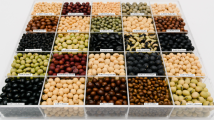Abstract
Seed protein extracts from 477 Japanese soybean cultivars were analyzed by polyaery lamide gel electrophoresis to determine the distribution of the alleles of the Ti (Ti a,Ti b,Ti c) and Sp1 (Sp 1 a,Sp 1 b loci with respect to maturity group and district of adaptation of each cultivar. About 60 percent of the soybean cultivars had theTi a allele. The frequency of theTi b allele was found to be highest in the southeast district and lowest in the northeast district. TheTi c allele discovered in 6 cultivars was traced to two possible sources adapted in the Tohoku District. TheSp l a, allele was found in 26 cultivars ranging from Maturity Group II through VIII. The summer season type cultivars adapted to the Kyushu District having the genotypeTi b Spl b probably played a major role in the peculiar accumulation of theTi ub allele and the decrease of theSp l a allele in the Japanese soybean cultivar population.
Similar content being viewed by others
Literature Cited
Birk, J. 1961. Purification and some properties of a highly active inhibitor of trypsin and chymotrypsin from soybeans. Biochim. Biophys. Acta 54:378–381.
Clark, R. W., D. W. Mies, and T. Hymowitz. 1970. Distribution of a trypsin inhibitor variant in seed proteins of soybean varieties. Crop Sci. 10: 486–487.
Eldridge, A. C., R. L. Anderson, and W. J. Wolf. 1966. Polyacrylamide gel electrophoresis of soybean whey proteins and trypsin inhibitors. Arch. Biochem. Biophys. 115: 495–504.
Frattali, V., and R. F. Steiner. 1968. Soybean inhibitors I. Separations and some properties of three inhibitors from commercial crude soybean trypsin inhibitor. Biochemistry 7: 521–530.
Hymowitz, T. 1973. Electrophoretic analysis of SBTI-A2 in the USDA soybean germplasm collection. Crop Sci. 13: 420–421.
—, and H. H. Hadley. 1972. Inheritance of a trypsin inhibitor variant in seed protein of soybeans. Crop Sci. 12: 197–198.
—, D. W. Mies, and C. J. Klebek. 1971. Frequency of a trypsin inhibitor variant in seed protein of four soybean populations. E. African Agric. For. J. 37: 73–77.
—, J. H. Orf, N. Kaizuma, and H. Skorupska. 1978. Screening the USDA soybean germplasm collection for Kunitz trypsin inhibitor variants. Soybean Genetics Newslett. 5: 19–24.
Kunitz, M. 1945. Crystallization of a soybean trypsin inhibitor from soybean. Science 101: 668–669.
Laboratory of Soybean Breeding, Tohoku Agric. Exp. Sta. 1967. The new soybean variety “Nema- shirazu” (in Japanese). Bull. Tohoku Agric. Exp. Sta. 35: 43–44.
Larsen, A. L. 1967. Electrophoretic differences in seed proteins among varieties of soybeans,Glycine max (L.) Merrill. Crop Sci. 7: 311–313.
—, and B. E. Caldwell. 1968. Inheritance of certain proteins in soybean seed. Crop Sci. 8: 474–476.
——. 1969. Source of protein variants in soybean seed. Crop Sci. 9: 385–387.
Nagata, T. 1960. Studies on the differentiation of soybeans in Japan and the world. Mem. Hyogo Univ. Agric, Agron. Ser. 4, 3: 63–102.
Orf, J. H., and T. Hymowitz. 1976. The gene symbolsSp 1 a andSp l a assigned to Larsen and Caldwell’s seed protein bands A and B. Soybean Genetics Newslett. 3: 27–28.
——. 1977. Inheritance of a second trypsin inhibitor variant in seed protein of soy-beans. Crop Sci. 17: 811–813.
——. 1978. Soybean linkage tests between two seed proteins and other characters. Soybean Genetics Newslett. 5: 22–24.
——. 1979. Inheritance of the absence of the Kunitz trypsin inhibitor in seed protein of soybeans. Crop Sci. 19: 107–109.
Rackis, J. J., and R. L. Anderson. 1964. Isolation of four soybean trypsin inhibitors by DEAE- cellulose chromatography. Biochem. Biophys. Res. Commun. 15: 230–235.
——, H. A. Sasame, R. K. Mann, R. L. Anderson, and A. K. Smith. 1962. Soybean trypsin inhibitors: Isolation, purification and physical properties. Arch. Biochem. Biophys. 98: 471–478.
Singh, L., C. M. Wilson, and H. H. Hadley. 1969. Genetic differences in soybean trypsin inhibitors separated by disc electrophoresis. Crop Sci. 9: 489–491.
Yamamoto, M., and T. Ikenaka. 1967. Studies on soybean trypsin inhibitors. I. Purification and characterization of two soybean trypsin inhibitors. J. Biochem. (Tokyo) 62: 141–149.
Author information
Authors and Affiliations
Additional information
Contribution from the Crop Evolution Laboratory, Department of Agronomy, University of Illinois at Urbana-Champaign, Urbana, Illinois. Research supported in part by the IllinoisAgric. Exp. Sta., and the Illinois Crop Impr. Assoc.
Rights and permissions
About this article
Cite this article
Hymowitz, T., Kaizuma, N. Dissemination of soybeans (Glycine max): Seed protein electrophoresis profiles among Japanese cultivars. Econ Bot 33, 311–319 (1979). https://doi.org/10.1007/BF02858260
Received:
Accepted:
Issue Date:
DOI: https://doi.org/10.1007/BF02858260




